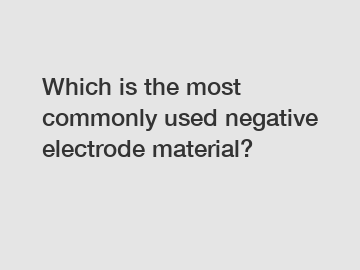Dec. 26, 2023
Minerals
In our quest for renewable and sustainable energy sources, lithium-ion batteries have emerged as a game-changer. These compact energy storage devices have revolutionized the way we power various portable electronics, electric vehicles, and even entire homes. At the heart of these batteries lies a negative electrode, which plays a crucial role in the energy transfer process. Join us as we dive into the realm of negative electrode materials, uncovering the most commonly used substance in this domain.
Negative Electrode Materials: A Primer.
Before we delve into the most commonly used negative electrode material, let's first understand its importance. In lithium-ion batteries, the negative electrode, or anode, is responsible for storing and releasing lithium ions during charge and discharge cycles, respectively. The material used in the negative electrode must possess exceptional electrochemical properties, stability, and a high capacity to accommodate the lithium ions.

The Most Commonly Used Negative Electrode Material: Graphite.
When it comes to the negative electrode material used in the majority of lithium-ion batteries, graphite takes the lead. Graphite offers a unique combination of desirable properties that make it an ideal choice for this crucial battery component.
Graphite's Structure and Electrochemical Properties:
Graphite is a form of carbon that adopts a layered crystal structure, consisting of hexagonally arranged carbon atoms. This layered structure facilitates the intercalation of lithium ions between its layers during the charging phase. Graphite can store up to one lithium ion for every six carbon atoms, making it an efficient option for energy storage.
Stability and Safety:
Graphite exhibits remarkable stability during repeated charge and discharge cycles, ensuring the longevity and reliability of the battery. Its high chemical stability minimizes the chances of side reactions, preventing degradation and increasing the overall safety of the battery.
High Capacity and Energy Density:
Further reading:One of graphite's standout features is its remarkable capacity to store and release lithium ions. This property directly impacts the energy density of the battery, enabling it to hold a substantial amount of energy within a compact space. High energy density batteries are essential for a wide array of applications, including electric vehicles, smartphones, and renewable energy storage solutions.
Environmental Considerations:
In addition to its exceptional electrochemical properties, graphite is considered environmentally friendly compared to other negative electrode materials. Its abundance in nature and low manufacturing impact contribute to its popularity as a sustainable energy storage component.
Graphite's Limitations:
While graphite is the go-to choice for negative electrode material, it does have limitations. One of the most significant disadvantages is its theoretical capacity limit. Graphite can only accommodate a certain amount of lithium ions, restricting its potential to achieve even higher energy densities. Additionally, in certain high-power applications, graphite's performance may be insufficient due to its relatively low rate capability, leading researchers to explore alternative materials.
The Pursuit of Alternative Negative Electrode Materials:
The ever-growing demand for more efficient and powerful batteries is driving research and development in search of alternative negative electrode materials. Scientists are exploring various options, including silicon, tin, and even lithium metal itself, to overcome the limitations of graphite-based anodes. These alternative materials hold the promise of higher energy density and improved power capabilities, propelling battery technology to new frontiers.
Conclusion:
Graphite has undoubtedly established itself as the most commonly used negative electrode material in lithium-ion batteries. Its exceptional electrochemical properties, stability, safety, and capacity make it the go-to choice for various applications. However, ongoing research and development indicate that there are exciting alternatives on the horizon, promising even greater energy density and performance. As we continue to shape the future of energy storage, we eagerly await the next breakthrough that will revolutionize the landscape of negative electrode materials forever.
Contact us to discuss your requirements of Carbon Graphite Products Factory, Negative Electrode Material of Power Battery, graphite crucible sizes. Our experienced sales team can help you identify the options that best suit your needs.
Further reading:Previous: Exploring the Versatile Applications & Benefits of Hot Rolled Steel Wire Rod for Industrial Usage
If you are interested in sending in a Guest Blogger Submission,welcome to write for us!
All Comments ( 0 )